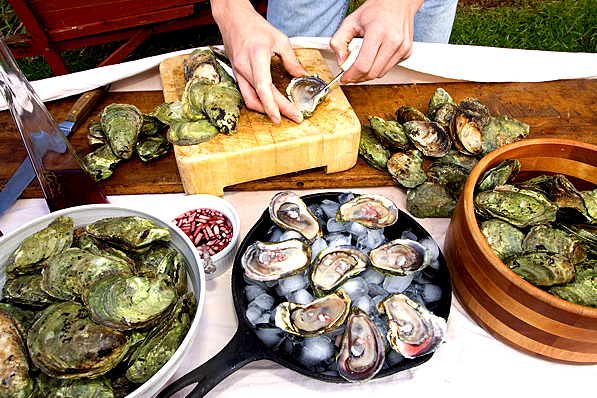The oysters and mussels from Prince Edward Island, along with prodigious amounts of herring and mackerel and snow crab and some two dozen other species of fish and shellfood, are shipped all over the world, but the island’s soft-shell cleams, or longnecks as they’re also called, don’t travel real well. Mostly because they’re so fragile (which explains why they’re called soft-shells).
So the only thing to do is dig them for yourself, which is what I figured I’d do yesterday. I borrowed a shovel and pail from Liam Dolan, a most expert mudder (a mudder being anyone who digs in the coastal mud for shellfish). Now all I needed to do was figure out where in the heck to go clamming.
Now if you ask Liam, who in addition to being an excellent mudder is the proprietor of the Claddagh Oyster House in Charlottetown, where the very best beach is to dig soft-shell clams, he won’t tell you because, after all, that’s where he goes.
But if you compliment him on his seafood chowder which, in the past, has taken first place in the PEI Shellfish Festival chowder competition, which I am here to judge, and then slyly ask him where the second-best beach is, he might suggest that, if you’re serious about it, “You go give the south shore a try.”
Which sounds helpful until you realize that the south shore runs for a good hundred miles. Then he’ll give you an Irish-tinged laugh (which came first to PEI, the Irish or the potato? It’s hard to say), offer to buy you a Guinness and a bowl of soft-shells at the Claddagh Oyster House. Which is exactly what I did yesterday afternoon after spending a very cold, wet morning walking up one windy stretch of beach after another without finding a single clam.
Andrew Chase, the Toronto chef, joined me at Claddagh and after enjoying our first fragrant bowl of soft-shells, we ordered a second. And then a third. At which point our waitress sadly informed us that we’d cleaned them out. “You boys ate everything we had.”
No worries. There were still plenty of PEI mussels to be had. And after that, there was always the 100-count box of Raspberry Point oysters sitting on ice in the bathtub of Andrew’s hotel room.
The perfect Sunday dinner.
Tags: Canada, Prince Edward Island
-
Can you not get some kind of poison from too many shell fish? Because you seem to eat alot of it…I think the irish came before the potatoe in PEI…my thought as it is …har har
Smiles
-
If memory serves, the potato came from South America to Spain to Europe and the Islands. Then to the Colonies and to PEI. I suspect that the hardy potato went with the French or British to PEI, where almost immediately the Irish followed and made an industry of it. Today, the population claims (in descending order) Scottish, English, Irish, and French antecedents.
In addition to potatoes and shellfish, you should be able to find good Scotch there… -
Re Scotch: Look for moonshine. And what do they do with unmarketable potatoes?
Re shellfish poisoning (http://www.nzfsa.govt.nz/consumers/food-safety-topics/marine-biotoxin-alerts/types.htm):
There are four main kinds of toxic shellfish poisoning. The chemicals that cause toxic shellfish poisoning are produced by certain species of toxic algae and released into the shellfish when they eat the algae.
Paralytic shellfish poisoning (PSP) is caused by a group of chemicals called the saxitoxins and gonyautoxins. These chemicals all differ in their toxicity to humans and their proportions may vary, depending on the species of shellfish and the species of algae producing the toxin.
Toxic algae of the species Gymnodinium catenatum, Alexandrium minutum and Alexandrium catenella commonly cause PSP toxicity in New Zealand shellfish.Amnesic shellfish poisoning (ASP) is caused by Domoic Acid in shellfish. Symptoms are mainly gastrointestinal, especially at low levels, however about a quarter of cases experience neurological problems including memory loss that may be significant and permanent. Symptoms first appear within 24 hours and neurological difficulties within 48 hours. Toxic algae of the Pseudonitzchia genus produce Domoic Acid.
Neurotoxic shellfish poisoning (NSP) attacks the nervous system. Symptoms include difficulty in swallowing, double vision, unsteadiness and tremor, nausea, diarrhoea, vomiting, numbness, tingling of the mouth, lips and extremities. Difficulty in distinguishing between hot and cold is also a characteristic. Onset of symptoms is likely to be within 24 hours. NSP is sometimes produced by an algal species known as Karenia mikimotoi.
Diarrhetic shellfish poisoning (DSP) is caused by Okadaic Acid and related compounds. Symptoms are diarrhoea, nausea, and vomiting and abdominal pain. Acute symptoms usually occur within 12 hours and are of short duration. DSP group toxins are produced by a variety of phytoplankton species, mainly of the Dinophysis genus.
Comments are now closed.


5 comments